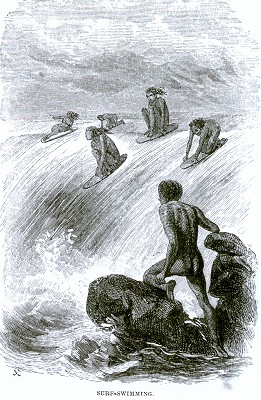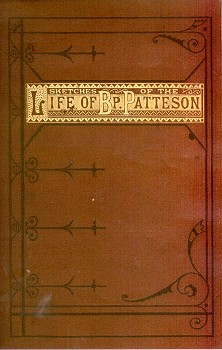
mrs selwyn : norfolk island, 1868
| home | catalogue | history | references | appendix |
 |
surfresearch.com.au
mrs selwyn : norfolk island, 1868 |
In August 1868, the Norfolk Island Mission was visited by Mrs. Selwyn, the wife of the New Zealand Bishop.
Norfolk Island was
previously a penal settlement established to disipline recalcitrant convicts
from Port Jackson (Sydney), but was now the home to some of the Bounty
descendants, who were relocated there in 1856 from Pitcairn Island.
These descendants
where the progeny of European sailors and Tahitian women, who on Pitcairn
retained surfboard riding as part of their Polynesian heritage and brought
their skills to Norfolk Island.
Although the book does not have a accredited author, it was probably by Charlotte Mary Yonge, an enthusiastic moral and financial supporter of Patteson's evangelical work, and largely based on his correspondence.
Also see:
1862 J.C. Patteson
: Santa Cruz Islands.
Extracts from Charlotte
Mary Yonge: Life of John Coleridge Patteson. Macmillan, London,1875,
Volume 1.
"Yonge" gives a brief
overview of the Norfolk residents, in particular noting their enthusiasm
for surfboard riding that was originally transfered from Tahiti (predominately
by females) to Pitcairn Island.
This section essentially
quotes the earlier report from Pitcairn by Dr. Ramsay in 1821.
See Source Documents:
1821 Dr David
Ramsay : Surfriding on Pitcairn Island.
Importantly, this
section does not appear in original 1873 edition, accredited to Yonge.
Ramsay's report
appeared in print as early as 1857 (and in Missionary journals? reference
need), for example:
Murray, Rev. Thomas
Boyles: Pitcairn: The Island, the People, and the Pastor; with a Short
Account of the original settlement and present condition of Norfolk Island.
Committee of General
Literature and Education Society for Promoting Christian Knowledge.
Society for Promoting
Christian Knowledge, Great Britain, 1857, Eighth edition, pages 209-210.
It is probable that the author included Ramsay's report based on Mrs. Selwyn's account, which appears as a footnote on page 64.
This highly personalised account, like Ramsay, was published previously:
Halcombe, Rev. J.J.
(editor): Mission Life- or The Emmigrant and the Heathen.
William MacIntosh,
24 Paternoster Row, London, 1868 (Volume 5), page 562.
The revelant section
is:
The Melanasian
Mission, page 519.
August 1868
CHAPTER XIII,
Mrs. Selwyn's Visit to Norfolk Island.
"Ondine"
"Ondines
(Latin: Onda — a wave) are elementals, enumerated as the water elementals
in works of alchemy by Paracelsus.
They also appear
in European folklore as fairy-like creatures; the name may be used interchangeably
with those of other water spirits."
-www.wikipedia.org
http://en.wikipedia.org/wiki/Ondine_mythology
The surfboard riding illustration facing page 64 is extremely rare for this period and is highly similar to the work of Wallace McKay, who also illustrated Charles Warren Stoddard's Summer Cruising in the South Seas, 1874.
Surfboard riding on Pitcairn Island was documented by other visitors, see:
1834 Frederick Bennett : Surfing on Pitcairn Island.
Surf-bathing was an established pastime on Norfolk Island for officers of the penal settlement, before the arrival of the Bounty descendants from Pitcairn in 1856.
See Source Documents:
1838-1843 Ensign Best : Norfolk
Island and New Zealand.
In the summer of 1911-1912:
"The North
Steyne Club has forwarded for confirmation to the Surf Bather's Association
a programme for the club's annual carnival.
Fifteen life-saving
clubs will be represented, and an exhibition of surf-shooting by Mr. L.
Bouffett, of
Norfolk Island
will be given."
- Sydney Morning
Herald, 1 December 1912, page 12.
(Noted in S&G
Champion:
Drowning,
Bathing and Life Saving (2000) page 159.)
Mr. Bouffett was
probably a descendant of John Buffett who arrived on Pitcairn Island
in December, 1823 on the British whaler, Cyrus.
The Pitcairn islanders,
largely decenced from Bounty mutineers and Tahitian women, were
renowned surfriders.
It may not be
amiss here to say a few words about the condition of the Norfolk Islanders
at this time.
The favourite
occupation of the men was whaling, and galloping after their cattle, varied
with work in their gardens and plantations.
The women were
chiefly occupied in attending to their dairies, and sewing for their numerous
families.
All were fond
of reading, and anxious to gather information of the world and its history.
Both sexes were
extremely industrious, usually rising at dawn.
Both morning
and evening each household assembled for family prayer.
Both boys and
girls learned to swim almost as soon as they could walk; consequently they
could swim through the roughest surf, and play about in the broken water
amongst rocks, without the slightest sense of danger.
One of their
great amusements is to have a ...
Page 64
... slide, as
they term it; that is, to take a piece of wood about three feet long, shaped
like a canoe, with a small keel, called a surf-board.
Holding this
before them, they dive under the first heavy sea, and come up on the other
side.
They then swim
out a little way, until they see a rapid, heavy sea come rolling in, the
higher the better; resting their breast upon the surf-board, they are carried
along on the very apex of the surf at a prodigious rate right upon the
rocks, where it would seem as if nothing could save them from being dashed
in pieces.*
(Footnote, originally
in diminished font)
Mrs. Selwyn's observations
are dated August 1868 in Halcombe (ed): Mission Life (1868), page562,
see above.
*Describing a
visit to Norfolk Island, Mrs. Selwyn says:
"Coming home
one beautiful evening, I met some girls going down to the jetty to see
fish which had been caught this calm day.
It was a pretty
sight indeed, in the brief twilight, the gay-looking fish lying on the
stones in the water, where the great waves were not rolling furiously in,
coloured by the glowing sky.
Some of my companions
longed to jump in.
'What! into those
great breakers?'
'That's the fun,'
whispered a young girl at my side.
At Pitcairn,
it seems, the' fun' was to swim out to sea, pushing a surf-board before
you, and then to come quickly back with it on the top of a huge roller.
" 'You can swim
?' asked a delicate-looking young mother of me, as we stood together; and
when I owned my ignorance, the compassionate, half-contemptuous tone of
her reply was very funny.
Men, women, and
children here take to the water like so many ducks.
The girls think
it a great pity that I, who am 'such a seafaring lady,' do not know how,
and offer to teach me.
'You would soon
learn from me,' said a noble-looking creature, reported, I believe justly,
to be the best swimmer of the party.
These fine days
promote a great desire for bathing.
It would be pleasant
before the sun was so hot as to blister them, which it seems it did dreadfully
at Pitcairn in the Christmas holidays, and no wonder, as they were chiefly
spent in the water.
Fortunately they
were short, as for six hours at a time would these mermaids remain in,
with their surf-boards, swimming races.
The great piece
of fun was for one to keep possession of a rock in the middle of Bounty
Bay, whence the rest would try to pull her down, and whence she would fling
them off into the water.
It sounded most
cool and brilliant, and as if they ought all to have been named 'Undine.'
A Christmas-tree
would be rather poor after this sport."
(Facing) Page 64
 |
This surfboard riding
image, opposite page 64,
|
 |
(Yonge, Charlotte Mary): Sketches of the Life of Bishop Patteson in Melanesia. "A Revised Edition of "The Life of Bishop Patteson." Society for Promoting Christian Knowledge, London, 1873. |

| home | catalogue | history | references | appendix |